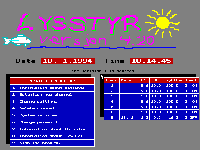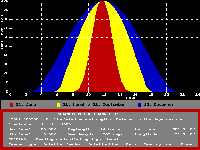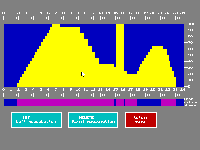- Light is a strong zeitgeber for syncronizing many biological rhythms.
- Important events in the life cycle of fish are influenced by annual light rhythm, such as
- smoltification in salmonids
- maturation (several species)
To simulate daily and annual rhythms automatic control is practical. - Dusk and dawn may play an important role in the life of animals, and in many cases has to be simulated if artificial lighting is to be used.
- The light level can be calculated for a given time and position by teoretically based formulas.
- By using a suitable choice of light sources, e.a. a combination of incandescent lamps and fluorescent lamps, the relative light level between 0 and 100% can be set in order to simulate natural light rhythms.
- To make such simulation easy, a PC program named, LYSSTYR has been developed.

Main menu LYSSTYR

Screen presentation of natural light rhythm

Static light rhythms can be
defined by drawing on the screen

Screen presentation of a static ligh rhythm
A computer program for light control
- Many possibilities for daily and annual light rhythms :
- Complete simulation of natural rhythms.
- Simulation of just dusk and dawn..
- ON/OFF cycle controlled by sunrise and sunset.
- Static light rhythms defined with almost no limitations by drawing the light-dark pattern using a mouse. It is easy to establish light periods for resonance-, T- and night-interuption experiments. - Both day and year may be shortened or extended to manipulate the rhythms, e.g. by use of a 9 month "year".
- Possible to control automatic feeders related to the light level, with use of normal, double or triple feeding intensity.
- Graphical interface, most operations can be made by use of computer mouse.
- Research laboratories working with biological rhythms or prosesses controlled by biological rhythms.
- Commercial fish farming, e.g. enclosed production systems for smoltification of salmonids.
- Lighting control systems based on the LYSSTYR program, and with Helvar LCS-system, are installed at Brattøra Research Station and other research stations and commercial sites in Norway, Iceland, Finland and Australia.